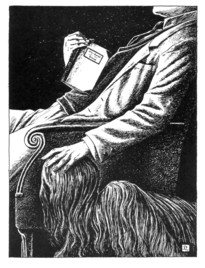“The Diary of Mr Poynter” is a ghost story by the English medievalist and author M. R. James (1862–1936), first published in his A Thin Ghost and OthersCollection of five short stories by the English medievalist and author M. R. James, first published in 1919. (1919).[1]
The story is written as a third-person narrative and concerns an apparently possessed scrap of chintzPrinted, painted, stained or glazed calico to which mordants and resists have been used to help dyes adhere., said to be a memorial to the hair of a 17th-century nobleman, an example of what James called “the malice of inanimate objects”.[2]
Synopsis
A couple of years before the story proper begins, Rendcomb Manor had been destroyed by fire. Its owner, James Denton, has just completed the construction of a new manor house, and is visiting London at the behest of his unmarried aunt, with whom he shares the property, to procure furnishings for the new house. After completing his errands, and having some time on his hands before his train back home, he visits a book sale, thinking that he may find some volumes on the history of his local area.
Denton comes across a four-volume set of the diaries of Mr Poynter, dated from about 1710. His bid is successful, and a few days later he receives delivery of the books, written by William Poynter, Squire of Accrington, about four miles away. But much to the displeasure of his aunt, Denton had forgotten to order the chintzesPrinted, painted, stained or glazed calico to which mordants and resists have been used to help dyes adhere. while in London.
On examining the diaries, Denton finds a scrap of cloth pinned to one of the pages, the design of which fascinates his aunt, who comments that its rippling, vertical lines remind her of hair. They agree to commission a firm to reproduce the pattern for their chintzes.
A month later Denton visits the chosen firm to view some samples, on which the vertical lines have been brought together at the top, as per his instructions. He asks if the fabric might be popular if it were made generally available, and is told probably not, and that it was certainly not popular with the craftsman who made the block, who seemed to sense that there was something evil in the design.
Six months later the chintz is delivered and the new mansion is finally furnished, with the new curtains put up in certain rooms, including Denton’s. Despite his initial satisfaction with the design, he does begin to regret having the vertical lines joined at the top, as the effect makes him feel that someone keeps peeping out from between the curtains. The following night, after having dozed off in a chair in his room, Denton begins to wonder where the spaniel that usually slept in his room might be. On moving his hand that is dangling over the side of the chair, he feels something hairy, and at first believes it to be his dog. But it doesn’t feel quite right, so he looks over the side of the chair to be met by the sight of what appears to be a rising human figure, with no discernable face, only hair.
Denton flees from his room and vacates the mansion the following day, taking the four volumes of Mr Poynter’s diaries with him to his temporary seaside lodgings. On examining again the page to which the scrap of chintz had been pinned, he comes across two pages that had been pasted together. He has no trouble in steaming the pages apart, and discovers that they contain an entry made in 1707 revealing the mysterious hair-like slithering creature to be a young nobleman, Everard Charlett, “a very beautiful person, and constantly wore his own hair, which was very abundant”.[a]It was fashionable in England to wear a wig from the late 17th until the late 18th century.[3] But he led a life of debauchery, and when he was found dead in the town ditch he was hairless, as if the hair had been plucked from his head.
Charlett was buried the following day, but was exhumed two years later so that his body could be moved to his country estate. During the process of transportation the coffin was accidentally broken, and was found to contain no trace of Charlett’s body, only hair.
The diary entry ends by observing it was said that Charlett had been so proud of his hair that he had commissioned the chintz fabric, the scrap of which had been pinned to the page, as a memorial to his hair. “The money spent upon the curtains [by Denton] might as well have been thrown into the fire, as they were”.
Adaptations
“The Diary of Mr Poynter” was adapted for BBC1’s children’s television as one of three readings by Michael Bryant, first broadcast on 12 December 1980.[4][b]The other two readings were “The MezzotinHorror story by M. R. James, first published in 1904, about an engraving that changes every time it is looked at.t”, broadcast on 21 November, and “A School StoryGhost story by M. R. James, first published in 1911, about the mysterious disappearance of a school teacher.“, broadcast on 28 November.[4]
See also
- M. R. James bibliographyList of the works written by M. R. James.
Notes
| a | It was fashionable in England to wear a wig from the late 17th until the late 18th century.[3] |
|---|---|
| b | The other two readings were “The MezzotinHorror story by M. R. James, first published in 1904, about an engraving that changes every time it is looked at.t”, broadcast on 21 November, and “A School StoryGhost story by M. R. James, first published in 1911, about the mysterious disappearance of a school teacher.“, broadcast on 28 November.[4] |
References
Bibliography
External links
- Full text of A Thin Ghost and Others at Project Gutenberg
- Reading by Michael Hordern on YouTube

